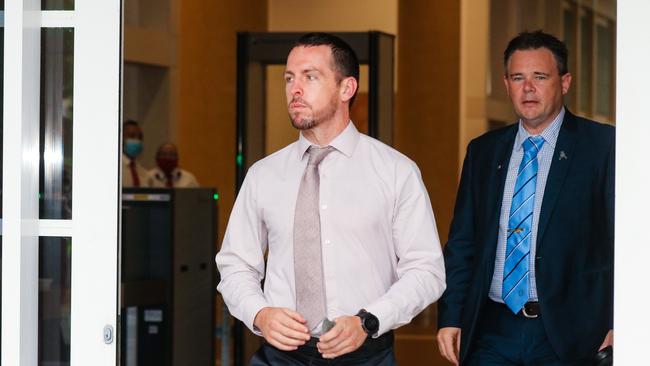Forensic tests back scissors cut to Zachary Rolfe
A pair of scissors found near where Kumanjayi Walker was shot could have caused cuts and tears to three areas of the police uniforms worn by Zachary Rolfe and his two colleagues.

A pair of scissors found near where Kumanjayi Walker was shot could have caused cuts and tears to three areas of the police uniforms worn by constable Zachary Rolfe and his partner, Remote Sergeant Adam Eberl, a jury has been told.
The conclusion based on analysis by an Australian Federal Police forensic chemist implies the Aboriginal teenager may have tried to stab both men while resisting arrest.
Constable Rolfe shot Walker three times after the latter inflicted a roughly 3mm puncture to his shoulder. Constable Rolfe is now facing charges of murder, manslaughter and engaging in a violent act causing death; he has pleaded not guilty.
Defence lawyers have consistently argued that Constable Rolfe was justified in using his firearm because the injuries he received could have been much worse.
Sergeant Eberl acquired a small scratch to his armpit but testified he did not feel himself being stabbed while trying to “ground stabilise” Walker and did not notice the injury until much later.
Northern Territory police detectives sent the two men’s uniforms to AFP forensic chemist Timothy Simpson to analyse. He determined the uniform damage could have been caused by a small, blunt blade.
The jury in Constable Rolfe’s trial has been told the scissors — also captured in bodyworn video — were about 130mm long, with a 50mm blade and blunt tips. They were stained with blood matching the DNA profiles of Walker, Constable Rolfe and Sergeant Eberl.
Mr Simpson conducted experiments by using the scissors to stab a pork belly clothed in police uniforms. He said the anatomy of a human shoulder “isn’t going to be best replicated by a pork belly” but that was the only scientifically acceptable material.
Defence lawyer David Edwardson QC asked whether “in respect of the three damaged locations, two – one on the front and one of the back in the case of Rolfe, and in the case of Mr Eberl, on the back – they were all consistent with, or you could not exclude, the sharp blade … of the scissors?”
“That’s correct, that blade or any other implement with the exact same gross morphological features as that implement could have caused that damage,” Mr Simpson replied.
Mr Edwardson pressed on how far the scissors penetrated the pork. Mr Simpson said he did not measure the depth but believed it was the length of the blade.
“That’s with moderate force?”
“That’s correct,” replied Mr Simpson. “In ideal circumstances, with moderate force.”
Constable Rolfe and Sergeant Eberl were part of a four-man police Immediate Response Team when they deployed to Yuendumu on November 9, 2019.
On Thursday, the jury heard from Sergeant Lee Bauwens, the officer in charge of the IRT, who described a procedure called “shove and shoot”.
“Arm goes up to either push or deflect. At the same time, the firearm is drawn and shot from the hip area,” he said. “So it’s an immediate drill to fire the gun as quickly as possible to counteract the knife attack. “
Constable Rolfe fired once when Walker stabbed him and twice more at “point-blank range” after Sergeant Eberl wrestled him to the floor. The charges Constable Rolfe is facing involve only shots two and three.
Sergeant Bauwens said the IRT’s primary role was to “cordon and contain” suspects under one of four planned scenarios. The court has heard the IRT team did not cordon the house where they suspected Walker was hiding and did not discuss before entering how to respond if they found him or if he turned violent.



